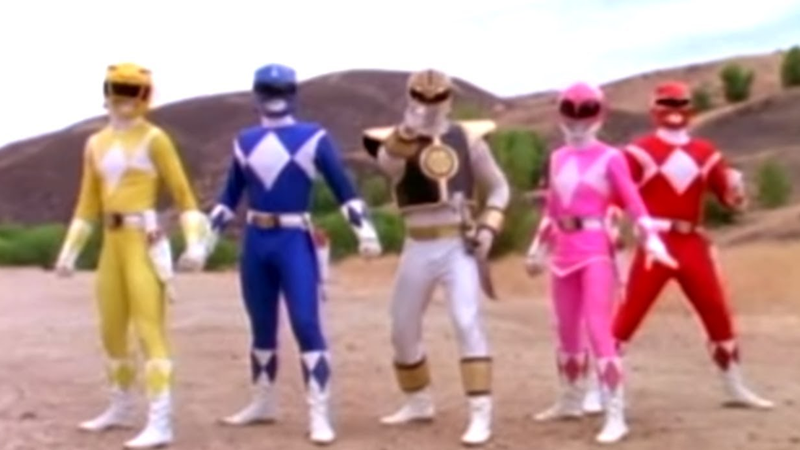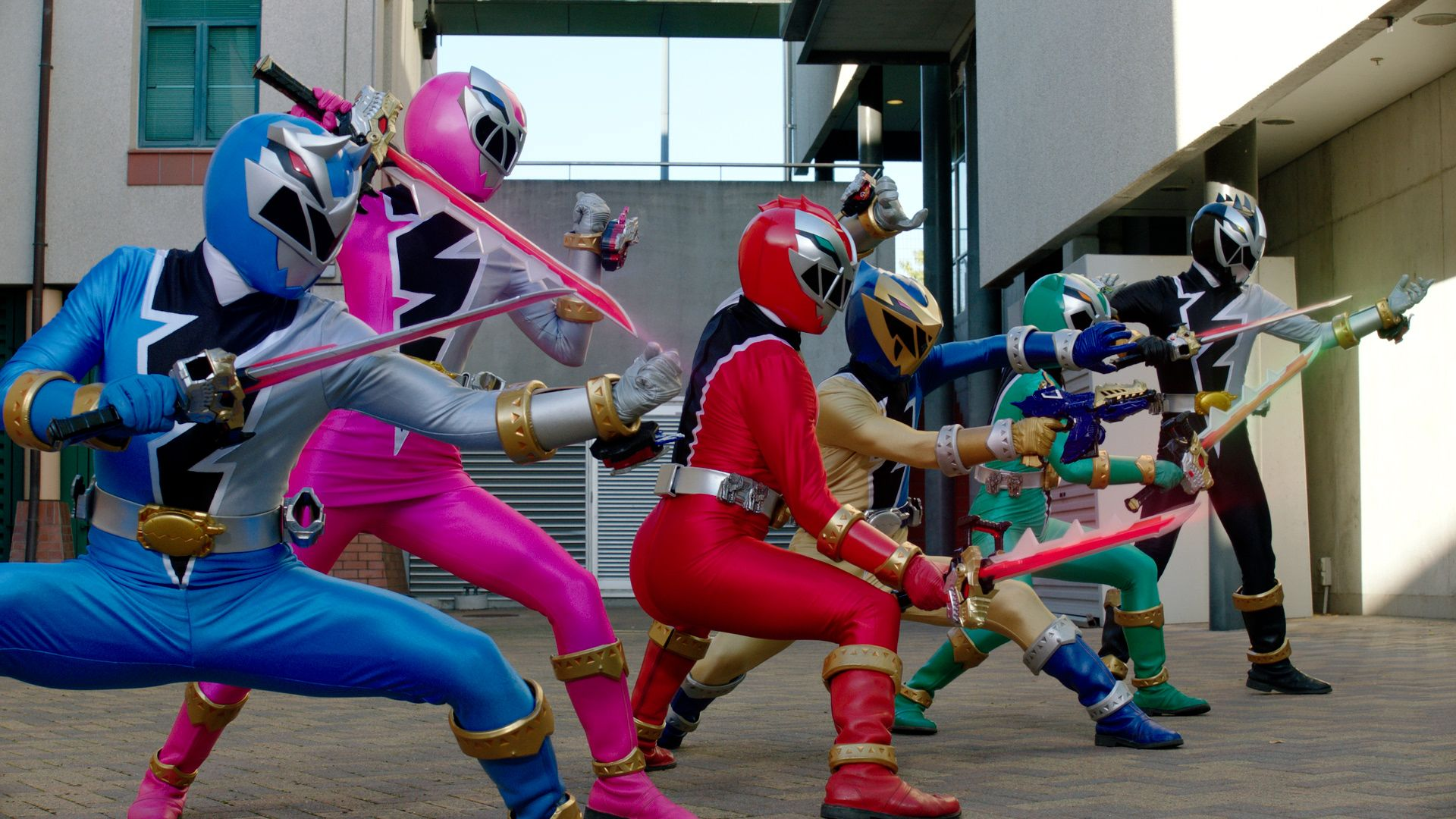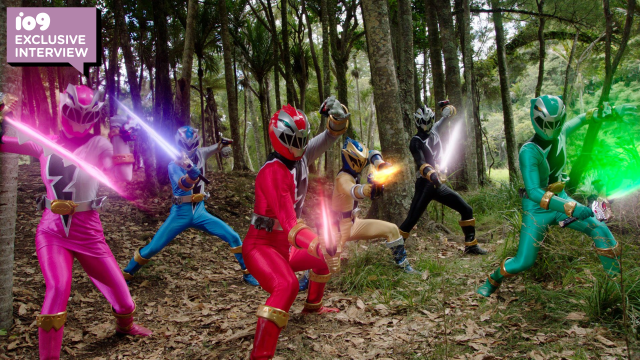Power Rangers has spent the best part of three decades encouraging kids to definitely not try the cool things they were seeing play out as the Spandex-clad superteam faced off against Rita Repulsa and her minions at home. That backflipping, explosion-framed action was brought to life by a dedicated team of stunt artists — and nearly 30 years on, one of them is still keeping the Ranger spirit alive.
Akihiro Yuji Noguchi has been working on Power Rangers almost since the very beginning, coming on board with the second season of the show as early ‘90s Ranger-mania saw Saban scramble to capitalise on the sudden hit series. Mighty Morphin’s first season had utilised as much material from its source Super Sentai series, Zyuranger, as it could, necessitating a new bid between Saban and Sentai creators Toei to film new footage featuring the series’ suits and creatures. But that also meant even more stunt work — and from there, Noguchi and his own team of stunt artist saw an opportunity to get on board.
All these years later, Power Rangers is still going, as is Super Sentai — and although their futures together might seemingly be on the cusp of some major evolutions, Noguchi’s relationship with Power Rangers is still as strong as ever with its current series, Power Rangers: Dino Fury. Now, he’s helping guide not just new generations of Rangers actors and stunt artists, but going behind the camera as well to help direct the series. Gizmodo recently spoke with Noguchi over email to learn more about his history with the franchise, his work as a second unit director on Dino Fury, and what it means for him to shape the strength, health, and safety of some of TV’s most beloved superheroes over the years. Check out our interview below, which has been condensed and edited for clarity.

James Whitbrook, Gizmodo: How did you come aboard working with the Power Rangers and Sentai stunt teams?
Akihiro Yuji Noguchi: In 1992, I joined with my colleagues, Tatsuro Koike and Koichi Sakamoto, as a hero stunt double in a film called Guyver: Dark Hero, shot in Los Angeles — it was part of the superhero genre, and it is a work that plays in a mask and a suit like the Power Rangers. It became a very highly acclaimed work in the action industry at that time. Taking this movie as an opportunity, Tatsuro, Koichi and I furthered our careers and began our stunt team: Alpha Stunts. Eventually, Power Rangers began airing and became a very popular program throughout the United States. It was so popular that the 405 Freeway was in heavy traffic due to audiences going to see the Power Rangers live show at Universal Studios! In 1993, we received an offer to participate in Mighty Morphin Power Rangers when we were active in Japan.
Due to our success with Guyver: Dark Hero, audiences knew about the existence of Alpha Stunts. Therefore, the production side may have decided that we were the best stunt team for the Power Rangers. We decided to gather other members and travel to the United States on a four-month contract. That’s how I got involved.
Gizmodo: You’re doing more than choreographing fight work on the show, you’re also training these casts for the physical shoot. When you’re beginning work on a new series of Power Rangers and a new cast, how do you start planning to train the oncoming team of actors?
Noguchi: We have been teaching actors in many series so far. In that process, an efficient action training manual was born naturally — rather than planning training for each new season, the focus is on developing the skills and abilities to respond to any choreography in a short amount of time, based on the manual [we built for the series]. We learn the actors’ strengths and weaknesses, and adjust the choreography and camera angle accordingly to create a situation where the actor can easily perform.

Gizmodo: One of the fascinating things about Power Rangers’ structure is its use of Sentai footage over the years. What’s your relationship with the Japanese stunt team like, and what challenges do you face in trying to create similar styles of stunts and fight sequences to what’s already there in the Japanese source material?
Noguchi: When we are in Japan, we often participate in Sentai programs with the Japanese stunt team. I sometimes participate in wire stunts, and most of the Power Rangers stunt teams are also involved in Sentai. Recently, we have been able to exchange information more easily.
I’ve been in Power Rangers as a stuntman since season two of Mighty Morphin Power Rangers, and at the beginning, there was no interaction with Toei’s Sentai team, so we could only learn from their footage. When Power Rangers series use Sentai footage, it’s necessary to match the atmosphere of the action with that of the Japanese material. We — the Power Rangers stunt team — studied the action of the Sentai team at that time while watching their footage, we wanted viewers to think that the action in Power Rangers was on par with Sentai. We were conscious of doing action that we did not do in Japan — there were some scenes that were difficult to match with the atmosphere of Japanese stunts, but we didn’t hesitate and prioritised the actions over the atmosphere. If it is a great action, it will blow away the viewer.
Gizmodo: Do you want to keep things cohesive, or try and experiment with different styles and techniques for each character and team?
Noguchi: Compared to Sentai, I feel that Power Rangers had more restrictions on action content. For example, getting hit in the face, strangling, trampling on a fallen enemy, etc. — these are common scenes in Sentai shows, but are seen as less appropriate in Power Rangers. When we watched the Sentai footage that was going to be used in Power Rangers, we ended up having to reshoot a lot. At that time, it took us a while to reshoot each shot, so to be honest, we found the regulation annoying. However, considering the frame of children’s programs, we thought it was a sensible rule. So we also thought about what to do to make the shot even cooler. For example, reshooting a facial hit — normally you can take a shot that hits the belly or avoid it by ducking, but while we hit the face, we avoid it with somersaults or used wires to avoid it in a flashier manner. We created new techniques while making good use of the regulations. Even now, when there are regulations or problems, I try to evolve by changing my way of thinking.
Since Power Rangers involves a team, it is necessary to have a sense of unity to the action, but it is not important to match everyone’s action style in figt work. In the action scenes, you should do what you are good at and focus on what you want to challenge. The more you try to unify, the less individual the movement will be. Power Rangers and Sentai shows have scenes where teams pose together instead — because there are times when everyone is fighting with a lot of individuality, when they get together and make a Sentai pose, the sense of unity as a team and the coolness of the heroes are further emphasised.
Gizmodo: Do you have a particularly memorable stunt you’re most proud of from your time on the series? What made it so important to you in the first place?
Noguchi: My favourite stunt I’ve done is the battle after the Red Ranger’s first transformation in episode two of Power Rangers S.P.D. It was a scene that was done with a fairly large setup in one shot, such as wire stunts and explosions. Despite incorporating explosions and wire stunts, all of which are difficult, we finished an energetic fight scene suitable for the first battle of the Red Ranger.
Gizmodo: What would you say has been the biggest change to how the series approaches stuntwork in your time on the franchise?
Noguchi: Moving the shooting location to New Zealand affected the stunts. American members [of the stunt team] have been with us for years, and we were now hiring New Zealand stuntmen who aren’t familiar with Sentai and Power Rangers as which naturally affects the quality of the action. We compensated with heavier use of wire work, which was quite effective at the time, but now, New Zealand stuntmen are mixed with Japanese stunt performers. However, at first after the move, most of the action in front of the camera was performed by Japanese stunt artists. New Zealand stuntmen weren’t used to that fight style — but they began to participate in the Japanese team’s action style and improved their comfortability in that regard.

Gizmodo: There’s been all sorts of discussion recently about the industry across film and TV not giving stunt work the credit it’s due — for example, awards categories at the Oscars or other technical awards. As a professional in the field, what do you hope audiences, Power Rangers fans or otherwise, take from seeing the sort of work you’ve done over the years?
Noguchi: There is no doubt that awards will motivate individuals in the field. I think it is very valuable because it can be a guide for the success of the younger generation who are aiming for that profession, not just those already involved.
I just want the industry to have more support for Power Rangers as a whole. Power Rangers has been a popular show for many years, but it’s a young person’s show, so it’s not talked about as much which is a shame. I want viewers and fans to enjoy the program as before, and parents to watch it with their children. Your child will learn that there are other professions in the process of growth. It’s a difficult world, but if you have a strong feeling, your wish will surely come true. If your child says they’re aiming to be a stunt performer, please don’t object, listen to their thoughts!
Gizmodo: You’ve been working on the physical side of Power Rangers for over two decades now. What do you think it is about the series that has kept it going across all these generations, and what is it that keeps you so involved with the franchise all these years later?
Noguchi: I have been involved in the Power Rangers series for many years — it has always been in my stunt life and presented new challenges for me that I’ve grown from. Among my colleagues at that time, there are many producers and directors who are currently active in the United States and Japan. Children who grew up watching Power Rangers are also now stuntmen and stunt coordinators, directors and producers. Don’t you think it’s wonderful?
We work to give our children dreams. A new generation will always be born, and eventually they will enter some kind of profession. Power Rangers is a series that tells such children what they need in their lives, such as friendship, teamwork, courage, and the importance of individuals. I want the show to be something that parents want to show to their children — that is also the reason why I continue to follow the rules of the MMPR era.
Episodes of Power Rangers: Dino Fury are currently streaming on Netflix.
Want more Gizmodo news? Check out when to expect the latest Marvel and Star Wars releases, what’s next for the DC Universe on film and TV, and everything you need to know about House of the Dragon and Lord of the Rings: The Rings of Power.
